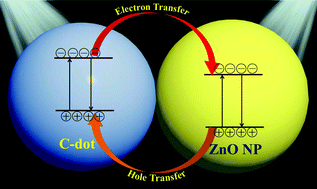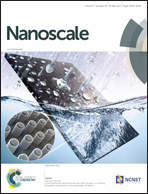An efficient charge separation and photocurrent generation in the carbon dot–zinc oxide nanoparticle composite†
Abstract
The development of light harvesting systems based on heterostructures for efficient conversion of solar energy to renewable energy is an emerging area of research. Here, we have designed heterostructures by using carbon dots (C-dots) and zinc oxide nanoparticles (ZnO NP) to develop an efficient light harvesting system. Interestingly, the conduction band and the valence band positions of ZnO NP are lower than the LUMO and HOMO positions of C-dots in this type II heterostructure of C dot–ZnO NP, which causes efficient charge separation and photocurrent generation. Steady state and time resolved spectroscopic studies reveal that an efficient photoinduced electron transfer occurs from C dots to ZnO NP and a simultaneous hole transfer occurs from the valence band of ZnO NP to the HOMO of C dots. The calculated rate of electron transfer is found to be 3.7 × 109 s−1 and the rate of hole transfer is found to be 3.6 × 107 s−1. The enhancement of photocurrent (11 fold) under solar light irradiation of the C dot–ZnO NP heterostructure opens up new possibilities to design efficient light harvesting systems.



 Please wait while we load your content...
Please wait while we load your content...